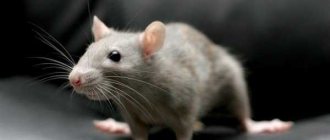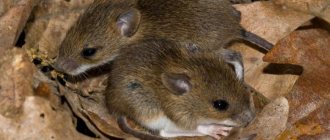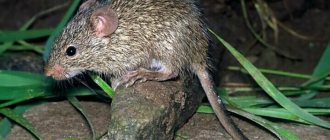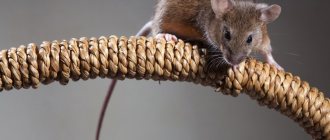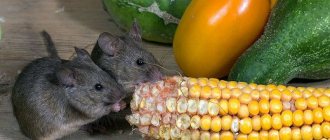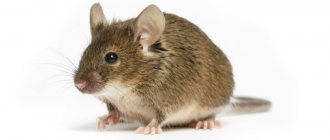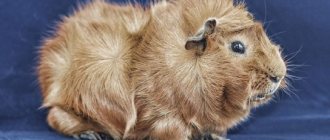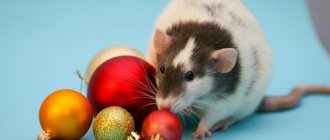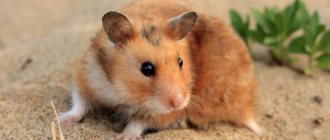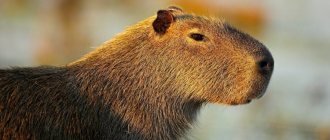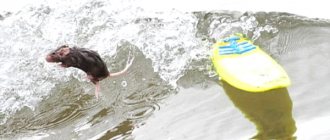Description of the rodent
— Advertising —
The body length of the spiny mouse is 7-13 cm, the tail is 6-13 cm long. The eyes are large, the ears are large and round in shape. The back is covered with spines reminiscent of a hedgehog. Color varies, ranging from pale yellow, tan and dark grey. The bottom of the body is covered with soft white hairs. In adult males, a peculiar mane of long fur forms on the neck.
Spiny mice have the ability to regenerate. When dangerous situations arise, they shed their skin, and scars do not form at the site of wounds, like all mammals, but their full regeneration occurs.
Natural enemies
The main natural enemies of this type of rodent are predatory mammals (steppe lynx caracal, desert fennec fox and others), reptiles and birds. In addition, Akomis have a competitive relationship with gerbils for food.
The needles made of bristles on the back, which are not only very stiff, but also divided into separate strands, help protect themselves from predators. Therefore, it is not easy for a predator who has caught this rodent to swallow it. Stubble is very irritating to the throat. This factor makes Akomis not a very desirable prey for enemies.
Feeding features of the spiny mouse
— Advertising —
Spiny mice are omnivores. They feed on plant (grain, oatmeal, oats, berries, vegetables and fruits, nuts, crackers, sunflower seeds, wheat, millet, dandelion) and animal foods (crickets, mealworms, caterpillars and dragonflies, flies, butterflies, sea fish and beef , eggs, cottage cheese).
When bred at home, crushed chicken egg shells are added to their diet to ensure the required level of calcium. And they give oranges as a treat. It is important to note that in captivity, spiny mice are prone to gaining excess weight.
Ratologist in veterinary clinics of the Vasilek network
In the network of veterinary clinics “Vasilek”, veterinarians Andrei Leontievich Kostrov and Irina Viktorovna Kologrivova, a veterinary specialist with extensive experience working with rodents, who, moreover, keeps several cute mice at home, conduct consultations.
Our branches in Solntsevo Park and Sculptor Mukhina successfully carry out operations on rodents, including sterilization of akomis. The clinic is equipped with the necessary
, which can significantly reduce operational risks for patients.
Urgent consultation with a veterinarian by phone, recommendations and advice from specialists on providing first emergency veterinary care to your pet. Emergency veterinary services from Moscow doctors for your pets at any time of the day!
Multiline phone
Common species of spiny mouse
Cairo mouse (Acomys cahirinus)
Larger than a house mouse. Body length 7.5-14 cm, tail length 9-14 cm, body weight 21-64 g. The eyes and ears are large, the muzzle is pointed, the tail is long, scaly, and there are spiny hairs on the back. The color is reddish-brown. The belly is white, the ears at the base, the stripes under the eyes and the legs on top are white.
The species is distributed in northeast Africa, Libya and Egypt, Sudan, Ethiopia and Djibouti.
Asia Minor spiny mouse (Acomys cilicicus)
Body length 10-12 cm, weight 48 g. There are hard, spiny hairs on the back. The eyes and ears are large, the tail is bare and short.
The species is endangered and endemic to Turkey.
Eastern spiny mouse (Acomys dimidiatus)
Body length 95-124 mm, tail length 93-122 mm, weight about 45 g. The body is orange-brown on top, the belly is white. There are black individuals.
Its habitat includes the Sinai Peninsula, Jordan, Israel, Lebanon, Syria, Saudi Arabia and Yemen, Oman and the United Arab Emirates, Iraq, Iran and Pakistan.
Cretan spiny mouse (Acomys minous)
The body length is 90-130 mm, the tail length is 90-120 mm, the weight is from 30 to 86 g. The okra is gray on top, gray-red on the sides, the belly is white. The eyes and ears are large, the tail is scaly, and the fur on the back is needle-like.
Endemic to the island of Crete, where the species lives in dry, rocky mountainous areas at altitudes of up to 1000 meters above sea level.
Golden spiny mouse (Acomys russatus)
Body length reaches 11 cm, tail length is about 7.5 cm, weight 37-75 g. Reddish-orange fur covers the entire body and camouflages the animal against the backdrop of sandy mountains. The sides and belly are whitish, the legs are gray with black soles. There are white stripes under the eyes.
It lives in Egypt, east of the Nile River, the Sinai Peninsula, Jordan and Israel, Saudi Arabia and north of Yemen, in Oman.
Distribution and habitat of akomis
The habitat of the spiny akomis is extensive - these are the countries of the Middle East (mainly Saudi Arabia), the hot lands of Africa, the islands of Crete and Cyprus.
Favorite habitats are deserts, rocky areas of savannas and canyons. Akomis are social animals; they prefer to live in groups, helping and protecting each member of the settlement. Burrows, usually left behind by other rodents, are used as housing and shelter. But they are quite capable of digging their own housing.
They are active at night or early in the morning. In search of food, they often approach people’s homes and even settle in burrows under houses. One such settlement can cause significant harm to the crops that people grow.
Behavior of the spiny mouse
The activity time of spiny mice is night and dawn. During the day they hide from the heat in their burrows, rock crevices and crevices in stones. They can climb trees. In a day, a spiny mouse can run about 15 km. In case of danger, the animal dissolves its fur and needles.
Akomis live in groups, the female being the main one. Individuals of the same group eat and sleep together, look after each other, for example, help during childbirth, and females often raise orphaned babies. When moving to another territory, all adult individuals carry both their own and other people's cubs.
Spiny mice are very clean and carefully look after themselves. Their kids are also always clean, the toilet is in one place.
Character
Spiny mice do best in a group. They are absolutely not aggressive, very sociable. They help each other in caring for their fur, and females raise their offspring together.
Akomis do not have good relationships with other domestic animals - they are always prey for cats, dogs and even birds. You shouldn’t risk letting the animals out for a walk; it’s better to provide them with a spacious and safe home. If there is a cat in the house, the tray needs to be properly protected, and a durable carabiner must be made on the cage.
For young children, close contact with mice can result in bites, and the pets themselves risk injury. Therefore, the cage must be placed in an inaccessible place and securely closed. Only children over 6 years of age who know how to handle animals can be trusted with pets such as spiny mice. At this age, the child is already quite capable of care, including feeding and cleaning the cage.
Reproduction of the spiny mouse
Pregnancy in a female spiny mouse lasts 4-5 weeks. In one litter there are 1-5 babies, who are born well developed with a body weight of about 7 g, are sighted at birth, and already reach puberty at the age of 2-3 months. The average life expectancy is 3 years, occasionally reaching 5 years.
Antiquity[edit]
Strabo calls mice born from the earth (gngeneis); according to his testimony, the Teucrians called them sons of the earth.
Among the Greeks, it is an attribute of Zeus (Jupiter), Sabazius and Apollo (it is assumed that the mouse served as food for his snakes).
According to Pliny, the Persian magicians considered mice to be the most religious animals. Ancient authors (Theophrastus, Aelian) noted the ability of mice to predict the weather, especially thunderstorms, by their behavior. The Greeks of Asia Minor had the belief that when marital fidelity is violated, mice cause terrible devastation in the house. In Greece, starting from the Homeric era, the cult of Apollo Smintheus (from sminyts “mouse”), whose attribute, symbol and sacred animal was the mouse, was widespread. Sometimes Apollo of Smyntheus was depicted standing on a mouse. Apollo was not only a destroyer of mice and a protector from them, but also their patron. Perhaps he himself was originally represented in the form of a mouse. Many mythological ideas about mice show similarities with ideas about muses in Greek mythology and characters genetically related to them. The parents of mice are the Thunderer (or sky) and mother earth (the wife of the Thunderer), the parents of the muses are Zeus the Thunderer or Uranus (sky) and Mnemosyne or Gaia (earth). The birthplace or habitat of mice and muses is a mountain (cf. the literal meaning of the proverb “The mountain gave birth to a mouse”). Mice are associated with fire, water, the world tree, muses - with a stone pillar. The leader of the mice is the mouse king or Apollo of Smyntheus, the leader of the muses is Apollo or Dionysus. Form of organization of mice and muses - round dance, attribute - arrow (through persecutors in mice, through Apollo in muses), functions (activities) - illness - health (causing damage - healing), blinding, singing, dancing, divination (fortune telling), memory - oblivion (whoever has tasted food touched by a mouse forgets the past; cf. the role of dead water, Lethe, opposing Mnemosyne, as well as the image of mice as the personification of death in different traditions), “fury”, trembling, chaotic revival (in mice before a thunderstorm , among the muses in connection with inspiration, creativity), etc. Ancient zoology mentioned their terrifying effect on elephants, their supposed conception through mutual licking and the view that mice in Egypt originated from the Nile mud and their liver increases and decreases depending on from lunar phases. The supposed voluptuousness of mice was the reason why they were depicted on coins along with the goddess of love Aphrodite (Venus).
Terracotta figurines of mice were found in excavations at the acropolis of Argos in Larissa (eastern Peloponnese). Apollo Sminteisky - protector from harm caused by mice
Interesting facts about the rodent:
- Spiny mice are often kept at home. To do this, purchase a glass aquarium, closed on top with a fine mesh. The area for five mice should be at least 90 cm by 30 cm by 40 cm. When using a cage, the cells in it should be 1 cm by 1 cm so that the mouse does not run away. The housing of the spiny mouse is located in a quiet, calm place, without bright sun and drafts. The floor is covered with a bedding of sand or corn cobs, and is changed as it gets dirty. To build a nest, mice are left with pieces of paper, cotton rags, straw, and hay. The temperature inside the cage should not drop below 27 ° C, and the humidity should not exceed 50%. Also, various ladders, ropes, floors and branches are placed in the mice’s home to maintain an active lifestyle and prevent the accumulation of excess weight. Spiny mice adapt very well to being kept in captivity, reproduce well and breed offspring. It is important to provide them with a varied diet, maintain cleanliness in the cage and the possibility of a very active lifestyle, so that the pets please their owners with their activity for as long as possible.
Care and maintenance of akomis at home
Spiny mice are not whimsical in their conditions of detention. If you follow a few simple tips, the animal will feel great away from the wild, and you will be touched by watching the vigorous activity of the little fidget.
In their natural environment, spiny mice live in groups. In order not to disturb the natural way of life, to buy not one, but at least two.
It is better to have two or more akomis
If you plan to breed rodents, then you need to choose pets in different stores to prevent mating of relatives. The offspring of such “blood ties” are characterized by reduced immunity and a tendency to diseases.
Before you go shopping, you need to prepare your future home. An ideal option would be an aquarium with a fine mesh lid. Do not skimp on its volume, as Akomis like to run a lot and climb various stairs, slides, and hollow logs.
Spinning the wheel is one of the animal’s favorite pastimes. It must be solid, without joints or cracks. This choice is due to the special fragility of the akomis tail. It breaks easily or comes off completely. Be very careful when handling your pet. Try not to touch his tail, and under no circumstances pull on it.
The bottom of the aquarium is covered with torn newspapers or sawdust. Spiny mice will be glad to have a cardboard house in which they can relax and raise their offspring. To maintain calcium balance, hang a rodent mineral rock in your aquarium.
According to reviews, Akomis are very clean. They immediately choose a corner where they will relieve their needs, and do not dirty the rest of the territory. General cleaning of the aquarium should be carried out two to three times a month.
To temporarily remove the mouse, it is better to use a plastic glass, drive the animal into it, and then cover it with your palm on top. This way you will avoid injury to the tail and will not scare the animal.
Health
Mice often develop tumors and, unfortunately, they are usually malignant. If you notice a lump, swelling, or other symptoms such as drowsiness and weight loss, these are signs of a tumor. Most tumors are removed by surgery, but they recur.
One of the most serious diseases for mice is “wet tail”. It is a gastrointestinal disease caused by bacteria in the digestive tract. If left untreated, the pet may die. The disease is manifested by diarrhea, drowsiness, lack of appetite and gait disturbance. This disease can be treated with antibiotics recommended by a veterinarian.
LiveInternetLiveInternet
—Categories
- Jokes about animals (14)
- Forest pests (5)
- Animation, pictures with codes, clipart (28)
- Dishes from forest gifts (159)
- Videos, flash drives (357)
- Mushrooms (212)
- Animal world (3403)
- animals (1021)
- Amphibians (140)
- Animal Matrix (443)
- insects (310)
- birds (791)
- Interesting (577)
- Calendar (46)
- Medicinal plants (113)
- Forest in painting (323)
- Forest backgrounds and schemes (67)
- Wild berries (32)
- Myths, stories, legends (40)
- Seas, oceans and their inhabitants (325)
- Our information (43)
- Forest and animal protection (229)
- Paleontology (26)
- The Nature of the World (1608)
- Australia (121)
- Asia (272)
- America (341)
- Antarctica (16)
- Africa (142)
- Europe (341)
- Nature of Russia (537)
- Natural phenomena, climate (277)
- About the forest (stories, stories, interesting facts) (250)
- Forest, mushroom frames (33)
- Plants (589)
- Rivers, lakes (185)
- Fishing (78)
- Poems about fishing, about nature and mushrooms. (101)
- Creativity (97)
- Photos (2098)
- Ecology, eco-facts (77)
- eco-projects (21)
- I am a photographer (reader photos) (336)
-Always at hand
—Search by diary
—Subscription by e-mail
-Statistics
Feeding
Spiny mice are omnivorous and completely unpretentious in food. Therefore, keeping them is not a hassle, although it is better to diversify the diet. It is based on grains - millet, oats, barley, wheat. Occasionally you can pamper your pet with seeds, nuts, berries, pieces of fruit or vegetables.
Akomis need animal protein, so once a week they are given mealworms or grasshoppers. A substitute for such a delicacy is cottage cheese, yogurt, boiled egg white, boiled chicken or liver. All this is required in small quantities. Everyone knows that representatives of this family love cheese, but it is not recommended to give it to small pets, because this product contains components harmful to them - salt and various preservatives. Any spicy or fatty foods are contraindicated for them.
The source of calcium, which the spiny mouse also needs, is crushed eggshells. In pet stores you can purchase special mineral stones intended for rodents, activated carbon and vitamin sticks. You just need to consult your veterinarian first.
Food should be in the feeder constantly, since metabolic processes in animals proceed quite quickly. It is only important to ensure that it does not lie too long and does not spoil. The water needs to be changed daily, and the feeder must be kept clean.
What kind of animal is that
Bats are a suborder of bats. The name is due to the anatomical structure: from the toes of the front paws through the sides to the hind limbs, an elastic membrane runs, connecting them (“hands” literally turn into wings). In nature, they prefer to settle in caves and rock crevices. In villages and cities they can be found in secluded dark places: in attics and abandoned buildings. They are characterized by a nocturnal lifestyle. Contrary to popular belief, they are not blind at all - they see (their vision is black and white), but they perfectly navigate in the dark thanks to their remarkably developed hearing.
On average, bats are small in size (comparable to small birds - tits, sparrows). At the same time, they are very nimble, and in flight they can reach speeds of up to 50 km/h. The body and head are covered with short fur that is soft to the touch, the muzzle, depending on the species, can be more or less similar to the muzzle of an ordinary mouse, but the ears of flyers are larger.
In the wild, these mice live for about 30 years. They will live a long time in captivity if the right conditions are provided.
